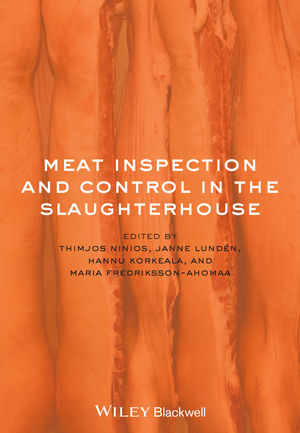Trichinellosis: A Worldwide Concern
By Jean Dupouy-Camet,
President of the International Commission on Trichinellosis,
French National Reference Centre for Trichinella,
Hôpital Cochin, René Descartes University, Paris, France
Trichinellosis is a zoonotic disease caused by the ingestion of raw meat containing larvae of the nematode Trichinella. Human trichinellosis causes high fever, facial oedema, myositis and eosinophilia. It can be a serious disease, particularly in elderly patients in whom neurological or cardiovascular complications can lead to death.
Trichinellosis is still present in Europe. In the past 30 years, horse meat has been identified as the main source of human trichinellosis in the EU with more than 3,350 cases reported in 14 outbreaks 1,2. However, the classical porcine vehicle remains. Small outbreaks due to wild boar meat are still reported in hunters and their families in France, Spain and Poland 3,4. Outbreaks due to infected pork have been reported in Spain and Germany and are still reported in Latvia and Lithuania 5,6,7,8. Until recently, Trichinella was considered to be absent from the Mediterranean islands but 10 infected pigs were found in Corsica in 2004 and, small outbreaks of pork-related trichinellosis involved patients in Sardinia in 2005 7,8. Infected foxes have also been found in Ireland, although this country was considered to be Trichinella -free 8. Is trichinellosis emerging in these islands or is the disease simply better recognized? These observations are good examples illustrating the difficulty to declare that some countries or areas are “Trichinella free”. Pork-related trichinellosis is frequently reported in Serbia, Croatia, Romania and Bulgaria where the disease has re-emerged in recent years 9. A survey performed by the International Commission on Trichinellosis (ICT) identified more than 1,100 trichinellosis cases in Europe for the year 2004, with 984 cases being reported from these four countries. The reliable use of sensitive methods requires adequate training, proficiency testing and performance in a recognised quality assurance system. Meat inspection for Trichinella in horsemeat was implemented in Europe in 1985 after huge outbreaks, but it did not prevent the subsequent occurrence of 10 additional outbreaks in France and Italy. Then, following the occurrence of two new outbreaks involving 550 cases in 1998 in the south of France, the meat inspection system was modified by implementing examination of larger samples and quality control. Consequently, two infected horses were detected, one in 1999, the other in 2001 7. However, these preventive measures cannot prevent the occurrence of trichinellosis from imported meat inspected in countries not belonging to the European Union and the risk still exists, as demonstrated by the occurrence of seven cases due to horse meat consumption reported in October 2005 in the north of Italy (E. Pozio, personal communication).
Source: Dupouy-Camet J, . Trichinellosis: still a concern for Europe. Euro Surveill 2006;11(1):5-5. Available online: http://www.eurosurveillance.org/em/v11n01/1101-222.asp
1. Pozio E., Zarlenga D.S. Recent advances on the taxonomy, systematics and epidemiology of Trichinella. Int J Parasitol. 2005, 35: 1191-1204.
2. Boireau P, Vallee I, Roman T, Perret C, Mingyuan L, Gamble HR, Gajadhar A. Trichinella in horses: a low frequency infection with high human risk. Vet Parasitol. 2000; 93 : 309-20.
3. Gari-Toussaint M, Tieulie N, Baldin J, Dupouy-Camet J, Delaunay P, Fuzibet JG, Le Fichoux Y, Pozio E, Marty P. Human trichinellosis due to Trichinella britovi in southern France after consumption of frozen wild boar meat. Euro Surveill. 2005 ;10:117-8. www.eurosurveillance.org/em/v10n06/1006-226.asp
4. Rodriguez de las Parras E, Rodriguez-Ferrer M, Nieto-Martinez J, Ubeira FM,Garate-Ormaechea T. Revisión de los brotes de triquinelosis detectados en España durante 1990-2001. Enferm Infecc Microbiol Clin. 2004 22:70-6. http://db.doyma.es/cgi-bin/wdbcgi.exe/doyma/mrevista.pubmed_full?inctrl=05ZI0106&rev=28&vol=22&num=2&pag=70
5. Bartuliene A., Jasulaitiene V. ,Malakauskas A. Human trichinellosis in Lithuania, 1990–2004. Eurosurveillance 2005;10 (7): 050714. www.eurosurveillance.org/ew/2005/050714.asp - 6
6. Noeckler K, Reiter-Owona I, Heidrich J, Protz D, Rehmet S, Sinn G, Ammon A. Aspects of clinical features, diagnosis, notification and tracing back referring to Trichinella outbreaks in north Rhine- Westphalia, Germany, 1998. Parasite. 2001;8:S183-5.
7. EFSA. First Community Summary Report on Trends and Sources of Zoonoses, Zoonotic Agents and Antimicrobial resistance in the European Union in 2004. www.efsa.eu.int/science/monitoring_zoonoses/reports/1277_fr.html
8. EFSA. Opinion of the Scientific Panel BIOHAZ on the “Request for an opinion on the feasibility of establishing Trichinella-free areas, and if feasible on the risk increase to public health of not examining pigs from those areas for Trichinella spp.” EFSA Journal, 2005, 277, 1-37. www.efsa.eu.int/science/biohaz/biohaz_opinions/1281/ biohaz_op_ej277_trichinella_fa_en1.pdf
9. Cuperlovic K, Djordjevic M, Pavlovic S. Re-emergence of trichinellosis in southeastern Europe due to political and economic changes. Vet Parasitol. 2005;132:159-66.
10. Ranque S, Faugere B, Pozio E, La Rosa G, Tamburrini A, Pellissier JF,Brouqui P. Trichinella pseudospiralis outbreak in France. Emerg Infect Dis. 2000;6:543-7. www.cdc.gov/ncidod/EID/vol6no5/ranque.htm




